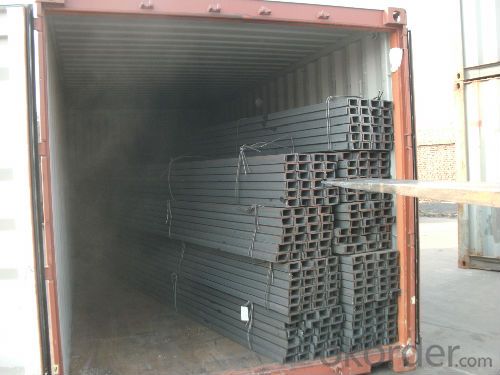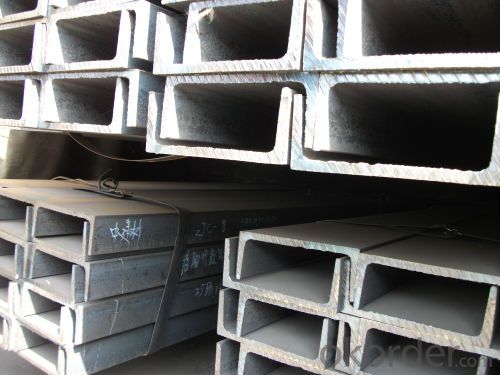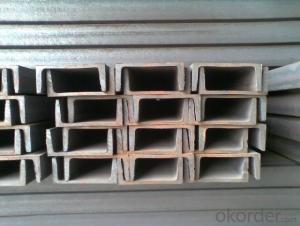Channel Bar Hot Rolled Mild U Channel Steel Bars
- Loading Port:
- Tianjin
- Payment Terms:
- TT or LC
- Min Order Qty:
- 100 m.t.
- Supply Capability:
- 35000 m.t./month
OKorder Service Pledge
OKorder Financial Service
You Might Also Like
OKorder is offering Channel Bar Hot Rolled Mild U Channel Steel Bars at great prices with worldwide shipping. Our supplier is a world-class manufacturer of steel, with our products utilized the world over. OKorder annually supplies products to African, South American and Asian markets. We provide quotations within 24 hours of receiving an inquiry and guarantee competitive prices.
Product Applications:
Channel Bar Hot Rolled Mild U Channel Steel Bars are ideal for structural applications and are widely used in the construction of buildings and bridges, and the manufacturing, petrochemical, and transportation industries.
Product Advantages:
OKorder's Channel Bar Hot Rolled Mild U Channel Steel Bars are durable, strong, and wide variety of sizes.
Main Product Features:
· Premium quality
· Prompt delivery & seaworthy packing (30 days after receiving deposit)
· Can be recycled and reused
· Mill test certification
· Professional Service
· Competitive pricing
Product Specifications:
Manufacture: Hot rolled
Grade: Q195 – 235
Certificates: ISO, SGS, BV, CIQ
Length: 6m – 12m, as per customer request
Packaging: Export packing, nude packing, bundled
Trademark | Rank | Chemical composition (quality score) % | |||||
C | Si | Mn | S | P | |||
≤ | ≤ | ≤ | |||||
Q235 | A | 0.14-0.22 | 0.30 | 0.30-0.65 | 0.050 | 0.045 | |
Q235 | B | 0.12-0.20 | 0.30 | 0.30-0.70 | 0.045 | 0.045 | |
Trademark | Rank | Pulling Test | |||||
Bend PointΔs/Mpa | Tensile Strength | Elongation Ratioδ5% | |||||
Thickness (Diameter) /MM | Thickness (Diameter) /MM | ||||||
≤16 | 16-40 | ≤16 | 16-40 | ||||
≥ | ≥ | ||||||
Q235 | A | 235 | 225 | 375-500 | 26 | 25 | |
Q235 | B | 235 | 225 | 375-500 | 26 | 25 | |
| JIS STANDARD CHANNEL | ||||||
| SIZE(MM) | h(mm) | b(mm) | s(mm) | t(mm) | kg/m | length |
| 50x25x3x6 | 50 | 25 | 3 | 6 | 2.37 | 6m,12m |
| 75X40x3.8x7 | 75 | 40 | 3.8 | 7 | 5.3 | 6m,12m |
| 75X40x4x7 | 75 | 40 | 4 | 7 | 5.6 | 6m,12m |
| 75X40x4.5x7 | 75 | 40 | 4.5 | 7 | 5.85 | 6m,12m |
| 75X40x5x7 | 75 | 40 | 5 | 7 | 6.92 | 6m,12m |
| 100X50x3.8x6 | 100 | 50 | 3.8 | 6 | 7.3 | 6m,12m |
| 100X50x4.2x6 | 100 | 50 | 4.2 | 6 | 8.03 | 6m,12m |
| 100X50x4.5x7.5 | 100 | 50 | 4.5 | 7.5 | 8.97 | 6m,12m |
| 100X50x5x7.5 | 100 | 50 | 5 | 7.5 | 9.36 | 6m,12m |
| 125X65x5.2x6.8 | 125 | 65 | 5.2 | 6.8 | 11.66 | 6m,12m |
| 125X65x5.3x6.8 | 125 | 65 | 5.3 | 6.8 | 12.17 | 6m,12m |
| 125X65x5.5x8 | 125 | 65 | 5.5 | 8 | 12.91 | 6m,12m |
| 125X65x6x8 | 125 | 65 | 6 | 8 | 13.4 | 6m,12m |
| 150x75x5.5x7.3 | 150 | 75 | 5.5 | 7.3 | 14.66 | 6m,12m |
| 150x75x5.7x10 | 150 | 75 | 5.7 | 10 | 16.71 | 6m,12m |
| 150x75x6x10 | 150 | 75 | 6 | 10 | 17.9 | 6m,12m |
| 150x75x6.5x10 | 150 | 75 | 6.5 | 10 | 18.6 | 6m,12m |
| 200X80x7.5x11 | 200 | 80 | 7.5 | 11 | 24.6 | 6m,12m |
FAQ:
Q1: Why buy Materials & Equipment from OKorder.com?
A1: All products offered byOKorder.com are carefully selected from China's most reliable manufacturing enterprises. Through its ISO certifications, OKorder.com adheres to the highest standards and a commitment to supply chain safety and customer satisfaction.
Q2: How do we guarantee the quality of our products?
A2: We have established an advanced quality management system which conducts strict quality tests at every step, from raw materials to the final product. At the same time, we provide extensive follow-up service assurances as required.
Q3: How soon can we receive the product after purchase?
A3: Within three days of placing an order, we will arrange production. The normal sizes with the normal grade can be produced within one month. The specific shipping date is dependent upon international and government factors, the delivery to international main port about 45-60days.
Images:



- Q:Are steel channels suitable for soundproofing purposes?
- Soundproofing purposes are not typically served by steel channels. Although steel channels can effectively provide structural support and stability, they lack the design to block or absorb sound. Soundproofing typically necessitates materials capable of absorbing or deflecting sound waves, like acoustic foam, mass-loaded vinyl, or soundproof drywall. These materials are engineered specifically to minimize sound transmission, whereas steel channels are predominantly employed for construction and support purposes. Hence, if soundproofing is the primary objective, it is advisable to consider alternative materials explicitly crafted for this purpose.
- Q:How do steel channels contribute to building stability?
- Steel channels play a crucial role in enhancing building stability by providing structural support and reinforcement. These channels, also known as C-channels or U-channels, are often used in construction to distribute loads and resist bending or twisting forces. One of the main ways steel channels contribute to building stability is by acting as beams or columns. When used as beams, they help to distribute the weight of the structure's floors or roof evenly, preventing excessive bending or sagging. Similarly, when used as columns, steel channels provide vertical support, ensuring the building remains upright and can withstand the load from upper floors or external forces such as wind or earthquakes. Furthermore, steel channels are often incorporated into the framing of walls, ceilings, and roofs. By connecting and reinforcing different structural components, they help to create a rigid framework that adds strength and stability to the overall structure. This is particularly important in areas where a building needs to withstand heavy loads, such as in high-rise buildings or industrial facilities. Moreover, steel channels are known for their high tensile strength, which means they can resist stretching or elongation under load. This property allows them to efficiently transfer and distribute forces throughout the building, minimizing the risk of structural failure. Additionally, steel channels have excellent fire resistance properties, which can further enhance building stability by providing a reliable barrier against fire and heat. In summary, steel channels contribute to building stability by providing structural support, distributing loads, resisting bending or twisting forces, and reinforcing various components of the building. Their versatility, strength, and fire resistance make them an essential element in construction, ensuring the safety and stability of buildings in various applications.
- Q:How do steel channels contribute to load distribution?
- Steel channels are structural components that play a crucial role in load distribution. They are designed to bear heavy loads and transfer them to various supporting elements of a structure, such as beams, columns, or walls. The shape and design of steel channels enable them to efficiently distribute the weight and forces applied to them. One of the primary ways steel channels contribute to load distribution is by providing a stable and rigid pathway for transferring loads. When a load is applied to a steel channel, it distributes the weight evenly along its length, preventing concentrated stress points. This even distribution helps to minimize the risk of structural failure or deformation under heavy loads. Furthermore, steel channels often act as secondary support members that help distribute loads to primary load-bearing elements. They can be attached to beams, columns, or walls to provide additional support and reinforcement. By connecting different structural elements together, steel channels effectively distribute loads across the entire system, preventing localized stress concentrations and ensuring the overall stability and strength of the structure. Moreover, steel channels can be used in combination with other structural components, such as steel plates or angles, to create composite sections that enhance load distribution capabilities. By combining different shapes and sizes, engineers can optimize load distribution by utilizing the specific properties of each component. In summary, steel channels are essential in load distribution due to their ability to evenly distribute loads, provide additional support to primary load-bearing elements, and create composite sections for enhanced load distribution. Their design and versatility allow them to play a critical role in ensuring the structural integrity and safety of various types of buildings and structures.
- Q:What are the applications of steel channels in the automotive industry?
- Steel channels are commonly used in the automotive industry for various applications. These channels are extensively utilized in the construction of vehicle frames, providing strength and rigidity to the overall structure. They are also used in the manufacturing of chassis components, such as cross members and reinforcements, to enhance the vehicle's structural integrity. Additionally, steel channels are employed in the fabrication of suspension systems and engine mounts, contributing to the stability and performance of automobiles.
- Q:Can steel channels be used for supporting solar panels?
- Indeed, steel channels have the capability to support solar panels. These channels are frequently employed in construction due to their robustness and resilience, rendering them well-suited for bearing the weight of solar panels. They furnish a sturdy and dependable framework for securing the panels in position, guaranteeing their correct installation and operation. Steel channels can be effortlessly tailored and modified to accommodate the precise demands of the solar panel installation, thus rendering them a flexible option for supporting solar panels. Moreover, steel channels provide protection against adverse weather conditions, ensuring the enduring stability and security of the solar panel system.
- Q:What are the different load capacities of steel channels?
- The load capacities of steel channels can vary depending on factors such as the size and shape of the channel, the type of steel used, and the specific application or design requirements. Generally, steel channels can have load capacities ranging from a few hundred pounds to several thousand pounds. It is important to consult engineering specifications or consult with a structural engineer to determine the exact load capacity of a specific steel channel for a particular application.
- Q:What type of channel steel and I-beam should be used to build an attic floor? Thank you!
- When the channel is fixed, the expansion bolt is used to see what the wall is. The casting can be expanded directly on the wall or fixed by the chemical bolts, and the brick wall needs slotting.
- Q:What are the different types of connections used for steel channels in bridges?
- Steel channels in bridges can be joined using various types of connections, each with its own benefits and considerations. Some commonly used connection types are as follows: 1. Welded connections: Welding is widely employed to connect steel channels in bridges. This method involves heating the materials until they melt and then fusing them together. Welded connections are renowned for their strength and durability. However, skilled labor and proper quality control are necessary to ensure the integrity of the welds. 2. Bolted connections: Bolted connections entail using bolts and nuts to fasten steel channels. This type of connection offers flexibility as it allows for disassembly and reassembly if required. It is also relatively easier to install and inspect compared to welded connections. Nevertheless, periodic maintenance may be needed to ensure the bolts remain tight. 3. Riveted connections: In older bridge constructions, rivets were commonly used. This method involves inserting a rivet into a pre-drilled hole and deforming it to secure the steel channels. Riveted connections provide good shear resistance, but they are less frequently used today due to the labor-intensive installation process and difficulties in inspection and maintenance. 4. High-strength bolted connections: High-strength bolts, which possess greater tensile strength than regular bolts, are commonly employed in modern bridge constructions. These connections offer high resistance to shear and tension forces. Specialized tools and careful installation are required to achieve the desired strength. 5. Moment connections: Moment connections are designed to transfer bending moments between steel channels in bridges. They are typically used in situations where the bridge is subjected to significant lateral forces, such as in earthquake-prone areas. Moment connections are usually welded and necessitate meticulous design and analysis to ensure their performance under different loading conditions. It is important to consider various factors, including bridge design, anticipated loads, construction techniques, and maintenance requirements when selecting connection types. Engineers and designers take these factors into account to determine the most suitable connections that will provide the necessary strength, durability, and safety for steel channels in bridges.
- Q:How do steel channels contribute to the sustainability of a building?
- Steel channels contribute to the sustainability of a building in several ways. Firstly, they are highly durable and have a long lifespan, reducing the need for frequent replacements or repairs. This minimizes the overall environmental impact associated with the production and disposal of building materials. Additionally, steel channels can be easily recycled at the end of their life cycle, reducing waste and conserving natural resources. Furthermore, steel channels are lightweight, allowing for more efficient transportation and installation, which reduces energy consumption during construction. Lastly, steel channels provide structural strength and support, allowing for the design of more sustainable and space-efficient buildings.
- Q:What are the different types of steel channel connections for mezzanine floors?
- There are several types of steel channel connections commonly used for mezzanine floors, including bolted connections, welded connections, and hybrid connections. Bolted connections involve using bolts to fasten the steel channels together, providing a strong and easily adjustable connection. Welded connections involve permanently joining the steel channels using welding techniques, creating a durable and rigid connection. Hybrid connections combine both bolted and welded connections, utilizing the benefits of both methods to achieve a secure and flexible connection.
1. Manufacturer Overview |
|
|---|---|
| Location | |
| Year Established | |
| Annual Output Value | |
| Main Markets | |
| Company Certifications | |
2. Manufacturer Certificates |
|
|---|---|
| a) Certification Name | |
| Range | |
| Reference | |
| Validity Period | |
3. Manufacturer Capability |
|
|---|---|
| a)Trade Capacity | |
| Nearest Port | |
| Export Percentage | |
| No.of Employees in Trade Department | |
| Language Spoken: | |
| b)Factory Information | |
| Factory Size: | |
| No. of Production Lines | |
| Contract Manufacturing | |
| Product Price Range | |
Send your message to us
Channel Bar Hot Rolled Mild U Channel Steel Bars
- Loading Port:
- Tianjin
- Payment Terms:
- TT or LC
- Min Order Qty:
- 100 m.t.
- Supply Capability:
- 35000 m.t./month
OKorder Service Pledge
OKorder Financial Service
Similar products
New products
Hot products
Related keywords




























